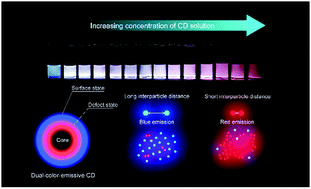Interparticle distance as a key factor for controlling the dual-emission properties of carbon dots†
Abstract
Due to their distinct and useful features, multi-color-emissive carbon dots (CDs) have gained much attention, however, their lack of red emission has so far limited their practical use for various applications, thus understanding of their emission origins is required. Concentration-dependent photoluminescence (PL) is a unique feature of CDs and is regarded as one way to realize tunable PL, providing information on their PL mechanism. In this work, we synthesized concentration-dependent blue/red dual-color-emissive CDs under single excitation at 365 nm. With the increase in concentration, the blue emission band showed a large red-shift from 431 to 500 nm, while the red emission band at around 650 nm showed only a relative intensity change, without a significant spectral shift. We performed spectroscopic analysis by changing the solution environment including the solvent type and pH to investigate the origins of the two emission bands. These results, combined with the zeta potential and fluorescence microscopy results, confirmed that the interparticle distance of CDs is a key factor for their dual-emissive PL behavior. With the advantage of unique PL features, we showed the potential of the CDs for white light-emitting diode (WLED) and ratiometric pH sensing applications.



 Please wait while we load your content...
Please wait while we load your content...